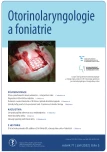The benefit of high-frequency audiometry – a retrospective study
Authors:
V. Svobodová 1
; O. Profant 2
; J. Kluh 1
; J. Plzák 1
Authors‘ workplace:
Klinika otorinolaryngologie a chirurgie hlavy a krku, 1. LF UK a FN v Motole, Praha
1; Klinika otorinolaryngologie a chirurgie hlavy a krku, 3. LF UK a FN Královské Vinohrady, Praha
2
Published in:
Otorinolaryngol Foniatr, 71, 2022, No. 3, pp. 119-130.
Category:
Original Article
doi:
https://doi.org/10.48095/ccorl2022119
Overview
Introduction: High-frequency audiometry is not usually carried out during routine hearing examinations. It is a frequently used method at the ENT Clinic of the University Hospital Motol (especially in patients being treated for tumours of the pontocerebellar angle), although the exact indicative criteria for this have not been determined. We aimed to characterize a group of patients, using a method which improved the accuracy of the diagnostics. Material and methodology: We analysed 1,515 audiograms retrospectively. These audiograms were performed by using audiometer MADSEN Astera of GN Otometrics during 2011–2018 in 773 adults, aged 16–80 (47.79 ±13.54). They all underwent high-frequency audiometry comprising of all commonly examined frequencies up to 8 kHz, and also at higher frequencies of – 9 kHz, 10 kHz, 11.2 kHz, 12.5 kHz, 14 kHz a 16 kHz. The indication was very diverse – subjective hypacusis/hyperacusis, tinnitus, vestibulopathy, acutrauma, or an already known diagnosis of a pontocerebellar tumour. Results: We identified a clinically significant asymmetry or pathological elevation of the hearing threshold, which was only detectable at frequencies above 8 kHz in 52 patients (6.73%). This group consisted of patients with vestibular schwannoma (48.08%), other tumours and vascular malformations of the temporal region (11.53%), vestibulopathy (3.85%), and patients that had never developed a serious pathology (23.08%). They were mostly patients with straightforward hypacusis or tinnitus. Conclusion: In clinical practice, there are cases of patients with a hearing defect that can only be detected when HFA is performed. HFA clarifies the diagnosis of hearing disorders and can lead to the detection of potentially life-threatening conditions such as tumours and vascular malformations of the otological area.
Keywords:
high-frequency audiometry – hearing loss – tinnitus
Sources
1. Dršata J, Havlík R, Chrobok V. Foniatrie – sluch. Havlíčkův Brod: Tobiáš 2015.
2. Beranová A, Čelakovský P, Vokurka J. Vývoj otoakustických emisí v čase u osob nastupujících do rizika hluku. Otorinolaryngol Foniatr 2002; 51(3): 150–153.
3. Havlíková E, Zeleník K, Komínek P. Stav screeningu sluchu novorozenců v ČR. Otorinolaryngol Foniatr 2015; 64(1): 13–16.
4. Calkoen EAV, Merkus P, Goverts ST et al. Evaluation of the outcome of CT and MR imaging in pediatric patients with bilateral sensorineural hearing loss. Int J Pediatr Otorhinolaryngol 2018; 108: 180–185. Doi: 10.1016/ j. ijporl.2018.02.022.
5. Tamplen M, Schwalje A, Lustig L et al. Utility of Preoperative Computed Tomography and Magnetic Resonance Imaging in Adult and Pediatric Cochlear Implant Candidates. Laryngoscope 2016; 126(6): 1440–1445. Doi: 10.1002/ lary.25659.
6. Valiente AR, Fidalgo AR, Villarreal IM et al. Extended high-frequency audiometry (9,000– –20,000 hz). Usefulness in audiological diagnosis. Acta Otorrinolaringologica Espanola 2016; 67(1): 40–44.
7. Fabijanska A, Smurzynski J, Hatzopoulos S et al. The relationship between distortion product otoacoustic emissions and extended highfrequency audiometry in tinnitus patients. Part 1: Normally hearing patients with unilateral tinnitus. Med Sci Monitor 2012; 18(12): CR765–CR770. Doi: 10.12659/ msm.883606.
8. Al-Malky G, Dawson SJ, Sirimanna T et al. High-frequency audiometry reveals high prevalence of aminoglycoside ototoxicity in children with cystic fibrosis. J Cyst Fibros 2015; 14(2): 248–254. Doi: 10.1016/ j.jcf.2014.07.009.
9. Mehrparvar AH, Mirmohammadi SJ, Davari MH et al. Conventional Audiometry, Extended High-Frequency Audiometry, and DPOAE for Early Dia gnosis of NIHL. Iran Red Crescent Med J 2014; 16(1): 6. Doi: 10.5812/ ircmj.9628.
10. Bass JK, Huang J, Hua CH et al. Auditory Outcomes in Patients Who Received Proton Radiotherapy for Craniopharyngioma. Am J Audiol 2018; 27(3): 306–315. Doi: 10.1044/ 2018_aja-18-0026.
11. Demerath T, Blackham K, Anastasopoulos C et al. Golden-Angle Radial Sparse Parallel (GRASP) MRI differentiates head & neck paragangliomas from schwannomas. Magn Reson Imaging 2020; 70: 73–80. Doi: 10.1016/ j.mri.2020.04.003.
12. Jilek M, Suta D, Syka J. Reference hearing thresholds in an extended frequency range as a function of age. J Acoust Soc Am 2014; 136(4): 1821–1830. Doi: 10.1121/ 1.4894719.
13. Kuhr E, Werner JA, Dietz A et al. Analysis of the emergency patients of a university ENT hospital. Laryngo-Rhino-Otol 2019; 98(9): 625–630. Doi: 10.1055/ a-0916-8916.
14. Shulman A. Subjective idiopathic tinnitus: a unified plan of management. Am J Otolaryngol 1992; 13(2): 63–74. Doi: 10.1016/ 0196-0709(92)90002-b.
15. Peris-Celda M, Graffeo CS, Perry A et al. Main Symptom that Led to Medical Evaluation and Dia gnosis of Vestibular Schwannoma and Patient-Reported Tumor Size: Cross-sectional Study in 1,304 Patients. J Neurol Surg Part B 2019; 80(3): 316–322. Doi: 10.1055/ s-0038-1675 175.
16. Burnier M, Egan BM. Adherence in Hypertension A Review of Prevalence, Risk Factors, Impact, and Management. CircRes 2019; 124(7): 1124–1140. Doi: 10.1161/ circresaha.118.313 220.
17. Taghizadeh E, Mardani R, Rostami D et al. Molecular mechanisms, prevalence, and molecular methods for familial combined hyperlipidemia disease: A review. J Cell Biochem 2019; 120(6): 8891–8898. Doi: 10.1002/ jcb.28311.
Labels
Audiology Paediatric ENT ENT (Otorhinolaryngology)Article was published in
Otorhinolaryngology and Phoniatrics

2022 Issue 3
Most read in this issue
- Isolated sphenoid fungal sinusitis – a case report
- Diagnostic and therapy of a cervical emphysema
- Results of treatment of olfactory disorders after COVID-19 disease using olfactory training
- Experience with awake craniotomy (performed in University Hospital in Ostrava) from the perspective of speech and language therapist
